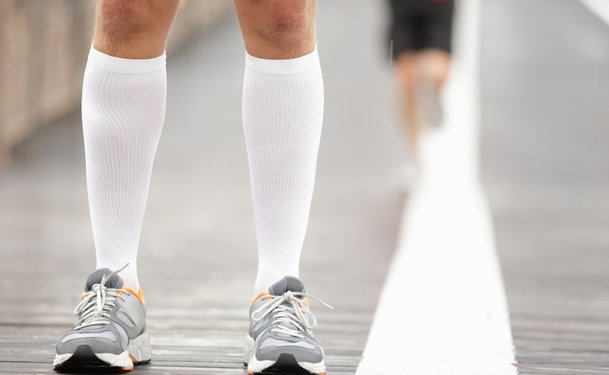Compression stockings are a common first-step treatment for vein problems, and are often prescribed to help you recover after other vein treatments or prevent conditions like blood clots. Learn the difference between compression stockings, hose, and socks, and find out how they can help you with your vein condition.
The difference between stockings, hose, and socks
Compression garments are differentiated by their intended purpose, pressure strength (measured in mmHG), length, and style. The two main categories are support hose, which are for mild conditions, and compression stockings, which are for more severe conditions. Whether a compression garment is called a sock, hose, or stocking depends on the length and style of the garment.
Support hose
Support hose are a category of compression garment that are designed to help alleviate mild vein conditions, boost circulation, and help with swelling. Support hose give light, graduated compression on your legs—usually less than 20 mmHG, and you can get them over-the-counter at most drugstores. Support hose are designed to be worn during your day-to-day activities.
Thromboembolic deterrent hose (TED hose) are a specific kind of support hose designed for people that are bed-ridden and at risk for developing blood clots. They aren’t intended to be worn for your regular day-to-day activities. They give light pressure of less than 20 mmHG and provide increased pressure on the calf muscle.
Compression stockings
Compression stockings are a category of compression garment that apply higher pressure to your legs and help with more serious vein conditions, circulation problems, and wounds. Compression strengths can range from 20 mmHG to 60 mmHG or more, and can require a prescription from your doctor and a special fitting from a medical supply store.
Lengths and styles
Compression garments, whether they’re in the support hose category or compression stocking category, can come in different lengths and styles. Lengths range from short socks to thigh-high stockings. Your doctor will help you decide which length is appropriate for your condition. Styles can vary from athletic-looking socks to panty-hose style, and come in all kinds of fashionable colors and patterns.
How compression stockings work
Compression stockings squeeze your legs to boost your circulation and help your veins move blood back up to your heart. This can help counteract the symptoms of venous insufficiency, which is a common condition where the one-way valves inside your veins don’t work properly and your vein walls stretch out. This condition can cause leg pain, spider veins, varicose veins, and in severe cases, skin ulcers.
Compression stockings are made of strong elastic or rubber that put gradual pressure on your leg. The pressure is stronger near the ankles and gets lower as you move up the leg. This gradual pressure is healthier for your circulation.
Uses for compression stockings
Doctors often recommend support hose and compression stockings to help with the day-to-day symptoms of venous insufficiency, but they aren’t a cure for this condition. They can often help with:
- Aches and pains
- Heaviness in the legs
- Swelling
- Sleep problems from vein-related issues
- Healing vein-related ulcers and wounds
Sometimes health insurance companies require you to use compression stockings first, before you can be eligible for other, more curative vein treatments.
Compression stockings are often combined with other vein treatments because they can increase treatment effectiveness, and they also help you heal. Compression stockings can be combined with procedures like surgery or sclerotherapy, where a chemical is injected into your varicose veins and spider veins to make them shrink, collapse, and eventually dissolve. Endovenous thermal ablation is another common treatment for vein problems, where a wire-like catheter is inserted into your varicose veins to heat and collapse them.
Wearing compression stockings while flying or sitting for long periods of time is an effective way to reduce the risk of developing deep vein thrombosis (DVT). DVT is a blood clot that that can form in your deep veins, usually in the legs. This is a serious and potentially life-threatening condition because the clot can block your blood flow or break away and travel to your lungs.
Costs of compression stockings
Stockings can range in price anywhere from about $10 to more than $100. They may be covered by your health insurance.
Updated March 15, 2017


